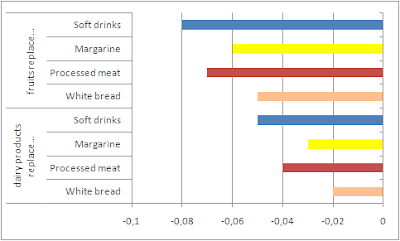 |
| Image 1: The EPIC project unites scientists from all over Europe (EPIC, IARC. 2011) |
Unfortunately the first of the typical shortcomings of EPIC studies (pun intended) like this becomes obvious in the previous citation, already, as the quotation marks before "waist circumference" indicate that the latter "was measured either at the midway between the lowest rib and the iliac crest (the Netherlands, and Potsdam-Germany) or at the narrowest torso circumference (the other centres)." And even worse,
at follow-up examinations, participants in Norfolk (United Kingdom) and Doetinchem (the Netherlands) were measured by trained technicians using the same protocols as at baseline, whereas other centres provided self-reported data.I guess you can imagine how "exact" these waist circumference are - if not, try and "measure" your personal waist circumference, you will be astonished how easy it is to "diet down" from 35" to 32"... it's a pitty that this kind of 'weight reduction' is not sustainable ;o)
Be that as it may, it argues in favor of the scientists that they did a validity test with 408 men and women from the Danish cohort beforehand and it turned out that "a high correlation between the self-reported and technician measured WC was found". Furthermore, the scientists were able to extrapolate association with baseline BMI and used these later in the regression analysis to make up for potential measuring "mistakes" on part of their subjects. If we thusly assume that at least this part of the data is reliable - I don't think I have to go into any detail as far as notoriously inaccurate food frequency questionnaires are concerned - the study provides some tangible insights into the influence the eating habits of the general population has on the accrual / loss of body fat.
 |
| Figure 1: Association (expressed as beta² coefficients, left axis) of certain foodstuffs and beverages (daily consumption in grams, right axis) with increases (positive beta²) and decreases (negative beta²) in waist circumference in 48,631 subjects from the EPIC-DiOGenes project (data adapted from Romaguera. 2011) |
 |
| Image 2: If you have any interest in milk, colostrum or dairy in general, make sure you read my recent write-up on milk and milk consumption! |
I bet, some of you are just about to freak out that both "vegetable oils", as well as pasta and rice and (worst of all) breakfast cereals are associated with reductions in waist circumference. At least in the eyes of the paleo-cultists out there, this may disqualify the study as devil's work ;-) People like Robb Wolf or Matt Lalonde, whose pointed analyses go beyond the common black-and-white cave-paintings you will find on the bazillion of paleo-blogs out there, would yet notice that the men and women in the study actually consumed relatively low amounts of these foods. Roughly 63g of rice and pasta for men and 52g for women is certainly a tolerable amount. And to be honest, I have not seen anybody die from a well filled tablespoon of vegetable oil per day, either ;-)
Almost "experimental" seems the last finding of the study I want to mention, which is the (calculated) effect the replacement of (-100kcal energy from) soft drinks, margarine, processed meat and white breads (the major offenders) with either (+100kcal from) dairy or fruits would have on the changes in waist circumference in the course of one year.
 |
| Figure 2: Model calculation of the beneficial (lower beta² coefficients) effects of iso-caloric (100kcal/day) replacements of soft drinks, margarine, processed meat and white bread by fruits or dairy (data adapted from Romaguera. 2011) |










0 comments:
Post a Comment